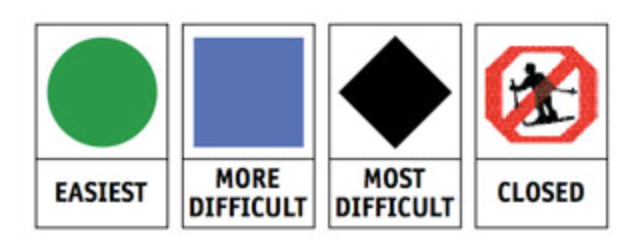
Safety Essentials
Each of the ski resorts offers a variety of facilities and ski runs, catering for beginner to advanced skiers and snowboards.
The following information is essential and relevant to all visitors to alpine areas, regardless of the length of the visit or the type of alpine activity. Children should be supervised at all times.
Planning and safety
Selecting a resort
When planning your trip, select an alpine resort which caters for your needs. Each ski resort offers a variety of facilities and ski runs, from beginner to advanced. Each of the resorts also operates an information service. Visit the resort websites to make a comparison between price, size, terrain and facilities.
Almost all alpine resorts in Australia allow snowboarding, although some have restrictions so check with the resort authorities before buying a lift ticket.
When planning your trip to the snowfields, select a resort or area which caters for you and your group’s needs as facilities, experiences and opportunities vary widely between resorts and various parts of the Alpine National Parks and high country.
Safety on the slopes
In Australia, most on-slope accidents occur on sunny days when people ski and ride faster or when the slopes and trails are more crowded.
It is strongly recommend that any person trying skiing or snowboarding for the first time should do so under the supervision of an experienced instructor. An instructor can both assist you to learn the sport more quickly and give you a good idea of which areas of the ski resort are suited to your skill level.
You can reduce the risk of injury by:
Skiing and riding in control.
Watching for other skiers and snowboarders.
Staying on slopes and trails that are within your ability.
Standardised trail markers indicating degree of difficulty appear at most resorts
Most ski resorts have standardised trail markers which are colour-coded to indicate the degree of difficulty. Free maps of runs and trails are also available from resort information offices. If new to the resort, start with the easier trails and work your way up to the more difficult trails, while ensuring you stay within your ability.
Do not try to ski or ride on a slope that is beyond your ability as you will endanger yourself and other skiers and snowboarders.
Be careful in the morning and the late afternoon as the snow may be icy. Do not assume that you will be able to ski or ride as well as you could the previous afternoon and always adjust your skiing and riding to the conditions.
Do not remove skis or snowboard on icy slopes
If you are lost, stay where you are
Be alert on ski lifts
Take ski or snowboarding lessons
Bindings must be fitted with retention devices
Always ski or board in control
Frozen Waterways
Do not ski, board or walk on frozen lakes, dams or creeks. In Australia, there is no guarantee that the ice will support the weight of a person.
Lift Riding
Broadly, there are two types of lifts: aerial lifts (chairlifts, gondolas, cable cars) and surface or drag lifts (pomas, T-bars, rope tows). If you are unsure how to use these lifts ask the lift attendant or get a lesson with a qualified instructor.
When riding lifts, remember the following:
Swinging or bouncing on the lift is dangerous.
Always unload smoothly and ski or board away from the unloading area.
Always use the safety bar on chairlifts.
Never drop litter from the lifts (or anywhere else).
If an aerial lift breaks down while you are on it, do not jump off. Wait for the lift attendants to evacuate you safely, with assistance from the Ski Patrol.
Let someone know before you go
Arrange to leave details of your trip with a responsible contact, for example a parent or teacher. For more information, see the Trip Intentions Form.
Ice Hazards
Icy conditions provide extra hazards to skiers and snowboarders. To ensure your safety on icy slopes take special note of the following:
Icy conditions are more likely in the morning and late afternoon.
Be aware of changing weather and snow conditions. The degree of difficulty of any slope is greatly increased when it is icy.
Choose runs that suit your ability, observe all slope signs and don’t let a friend talk you into skiing or snowboarding a run you don’t think you can handle.
If a friend is in danger or difficulty, don’t take unnecessary risks to rescue them. Seek assistance from Ski Patrol.
Skis and snowboards should be well tuned and in good condition so that they can handle icy conditions.
If you do fall on an icy slope, use the following techniques to arrest your sliding on the snow:
Edge your skis or snowboard into the ice to regain control of your speed.
Grasping your ski pole above its basket, thrust the point of the ski pole into the ice.
Icy conditions are particularly hazardous for snowboarders. Novice snowboarders should avoid boarding in icy conditions.
Safety checklist & Planning
There are some basic rules when going to the alpine region, even on the shortest trip.
Be Safety Conscious
Plan your trip carefully.
Know the signs of hypothermia.
Get fit to go skiing or snowboarding.
Let someone know before you go (download below).
Take your mobile phone and emergency contact numbers.
Take care on alpine roads.
Practice fitting wheel chains before leaving home.
Wear appropriate wind and waterproof clothing (never wear jeans while skiing or snowboarding).
Always wear a hat and gloves.
Wear skin and eye protection.
Take care of your equipment and check it before skiing or snowboarding.
Regularly check weather, snow and skiing or snowboarding conditions.
If you are lost, stop, seek shelter and wait for help.
Ski or ride within your capabilities.
Take skiing or snowboarding lessons.
Take extra care with children.
Eat appropriate food before and during snowsports and bushwalking activities.
Always ski or snowboard in control.
Drive cautiously, particularly in the snow.
Watch for weather changes.
Never ski or snowboard alone.
Never remove your skis or snowboard when conditions are icy, particularly on steep slopes.
Never ski, snowboard or walk over frozen lakes, dams or creeks.
Take care of the environment.
Keep your edge: Alcohol and drugs don’t cut it in the snow. Alcohol and drugs impair judgement, slow response time and reduce your ability to respond in an emergency.
Pre-season Fitness
Those with pre-existing medical conditions should avoid riding chairlifts or skiing/boarding on their own. Always be vigilant with precautions and symptoms. It is vital to keep taking your medication as prescribed while you are away.
It is strongly recommended that those going to the snowfields prepare themselves well in advance for their activity by participating in some form of pre-season fitness program to get fit to go skiing or snowboarding.
Skiing and snowboarding are aerobic activities which require flexibility, strength, endurance, speed and quick reflexes. A pre-season fitness program will improve your physical ability in these areas. If you are fitter you will have a more enoyable experience and lessen the chance of injury to yourself and other skiers and snowboarders. Children, as well as adults, can benefit from a pre-season fitness program.
Fitness Program Essentials
When taking part in any fitness program, the following points are vital:
Start your training well before the ski season or your trip.
Training sessions must be regular and frequent – at least three times per week.
Always warm up before an exercise session.
Advice for special health needs
Those with pre-existing medical conditions should avoid riding chairlifts or skiing or snowboarding on their own. Always be vigilant with precautions and symptoms. It is important that you keep taking your medication as prescribed while you are away.
Asthma
Anyone with asthma should be able to venture onto the slopes safely, by taking a few precautions. Even people whose asthma is triggered by cold conditions should be able to cope at high altitudes as long as the asthma is well controlled.
It is a good idea to have a written management plan, knowing what you need both for prevention and relief of your asthma, and what to do for deteriorating asthma.
Stock up on all the medication you require, as well as some extra. A letter from your doctor outlining the history and severity of your asthma and treatment is helpful to have on hand in case medical attention becomes necessary.
In freezing conditions, pressurised inhalers may not work properly. They should be warmed (in the hands, for example) before use. It is important to remember to keep taking your medication as directed while you are away.
Talk to your doctor and/or contact the Asthma Australia information line on 1800 278 462 as part of your preparation for taking part in recreational alpine activities.
Heart problems
There is no reason why people with heart conditions can’t partake in recreational alpine activities, as long as the right precautionary measures are taken.
The risk for people with heart conditions depends on the level of exercise they are doing. It is essential that someone with a heart problem planning on vigorous exercise takes an exercise stress test with their doctor before they go. This test can then be reviewed by a cardiologist who can help create a management plan for the prevention of any problems.
While at the snow, it is important to keep monitoring yourself and at the first warning signs and pains in your chest, stop what you are doing. Ensure that you keep taking medication as prescribed. It is not advisable for someone with a heart condition to drink excessive amounts of alcohol in the cold.
For more information on hitting the slopes with a heart condition, talk to your doctor and/or contact the Heart Foundation information line on 1300 36 27 87.
Diabetes
Alpine sports of all types can be safely undertaken by people with diabetes. The major potential problem is related to low blood glucose levels (hypoglycaemia) resulting from the increased and often sustained level of activity.
Discuss your intended activities with your doctor and develop a new dose schedule for your medication. This will usually involve a substantial reduction in insulin or tablet doses whilst you are engaging in alpine sports.
Ski or snowboard with a friend who is aware of your diabetes and knows how to recognise and treat hypoglycaemia. Always have some simple carbohydrates readily accessible. Jelly beans or soft jubes are ideal in the snow.
If you do become hypoglycaemic, have some simple carbohydrates immediately – don’t wait! Follow this up with a long-lasting carbohydrate such as a milk drink, fruit or sandwiches as soon as possible. Don’t resume your activity until after you have eaten.
Hypoglycaemia can occur soon after commencing exercise or many hours after the activity has ceased. Take special care to avoid overnight hypoglycaemia by intensifying your blood glucose monitoring a eating a substantial supper and considering reducing your overnight insulin.
Talk to your doctor and/or contact the Diabetes Australia information line on 1300 136 588 as part of your preparation for taking part in recreational alpine activities.
Prevent emergency situations
Emergencies are often the result of poor planning and/or foolhardy behaviour. If you do find yourself in a difficult situation, stop and think.
Awareness of your own ability is an important safety factor. Individual skills and fitness levels vary greatly. What is quite safe for one person to attempt may be foolish for someone else to try.
Know your ability and keep well within it at all times.

